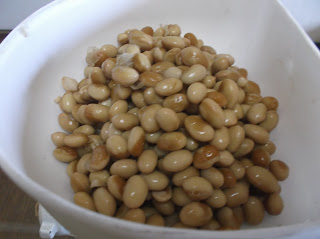Today, I helped my father make miso. He started the preparations (soaking the soybeans in water) two days ago.
今日は父の味噌作りを手伝いました。父は、二日前から準備(大豆を水に漬ける)を始めました。
7 sho (9.1 kg) soy beans.
1 sho soybeans weigh 1.3 kg.
1 sho is equivalent to 1,800 ml.
大豆7升(9.1 kg)。
大豆一升の重さは1.3 kg。
一升は1,800 mlです。
The other ingredients are:
7 sho rice koji
5 kg salt
他の材料は:
米麹7升
塩5 kg
Directions:
1. Boil soybeans until soft. Let them cool to 40 degrees C or lower.
2. Mill soybeans.
3. Add salt, add koji, and mix well. Add some water from the pot to adjust the texture.
4. Put in a container.
作り方:
1. 大豆を柔らかくなるまで煮る。摂氏40度以下に冷ます。
2. 大豆を挽く。
3. 塩を加え、麹を加え、よく混ぜる。鍋の水を足して、固さを調整する。
4. 容器に入れる。
Today, we started the work a little after 7 o'clock in the morning.
今日は、午前7時ちょっと過ぎに作業を始めました。
We needed to attend to the two pots for more than two hours!
2つの鍋に2時間以上を付きっ切りでした。
I checked the weight of the 7 sho koji my father had ordered.
父が注文していた7升の麹の重さを調べました。
10.5 kg (including the bag)
10.5 kg(袋を含む)
Probably around 10 kg.
たぶん10 kg程度です。
This is my father's "bean mill".
これが父の「まめひき」です。
Manual device. He said he should have bought an electric one.
手動の装置です。父は電動のを買うべきだったと言ってました。
Large plastic container:
大きなプラスチック容器:
To put the mixture in the container, you first make a ball and then hit it against the inner wall of the container so as to release the air.
混ぜ合わせた物を容器に入れるには、まず玉を作って、容器の内壁にぶつけて空気を抜くようにします。
Place a plastic sheet first on top of it and then a weight. No photo.
プラスチックのシートを上に敷いて、重りを載せます。写真はありません。
My father says that the miso will be made around November.
味噌は10月頃にできるだろうと言っています。
When boiled, soybeans increases by a factor of 2.5 in weight. 9.1 kg soybeans will be 9.1 x 2.5 = 23 kg. The 7 sho koji weighs 10 kg as I mentioned above.
Thus, the salt content of the miso is:
5/(23 + 10 + 5) x 100 = 5/38 x 100 = 13%
大豆は煮ると、重さが2.5倍になります。9.1 kgの大豆は9.1 x 2.5 = 23 kgです。7升の麹は、前述のとおり、10 kg。
よって、塩分量は、
5/(23 + 10 + 5) x 100 = 5/38 x 100 = 13%
Edited to add:
For miso, the salt content of 13% is quite normal. At a lower salt content, the miso is prone to get moldy.
My father says that the 7 sho (9.1 kg) soybeans cost around 5,000 yen, the 7 sho (10 kg) rice koji cost 7,000 yen, and the 5 kg cheap salt cost several hundreds of yen.
Thus, the price of the resultant 38 kg miso is around (5,000 + 7,000)/38 = 316 yen per kg.
NOTE: The weight of 1 sho rice koji varies depending on how dry it is, and is in the range of around 900 g to 1.2 kg.
追記:
味噌では、13%という塩分量はとても一般的です。これより低いと、味噌はかびやすくなります。
父が言うには、7升(9.1 kg)の大豆はおよそ5,000円、7升(10 kg)の米麹は7,000円、そして、安い塩5 kgは数百円だそうです。
よって、できた38 kgの味噌の値段は、1キロ当たり、およそ(5,000 + 7,000)/38 = 316円です。
注: 一升の米麹の重さは乾燥具合によって異なり、およそ900 g~1.2 kgの範囲です。










































